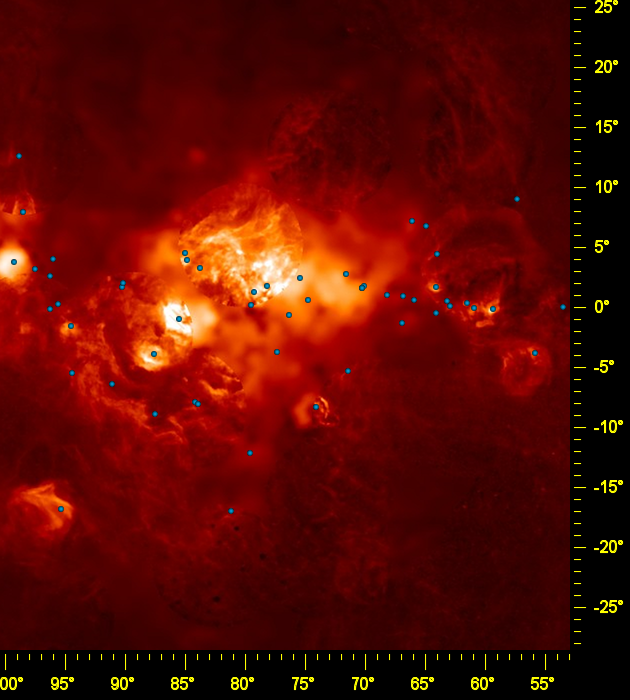
Hover your mouse over each blue dot for the name of the object, or click on the dot for a detail page. This map was created using the all-sky hydrogen-alpha map produced by Douglas Finkbeiner from data collected by the WHAM, VTSS and SHASSA hydrogen-alpha surveys.
Cygnus is one of the the closest major Milky Way regions to our solar system. If the Gould Belt is our local town, then Cygnus is the big city off on the horizon. Much of Cygnus is obscured by a complex of dust clouds called the Rift, so-called because they appear to create a large tear or rift in the Milky Way. Fortunately, astronomers can see through this dark dust by detecting other parts of the electromagnetic spectrum such as radio and infrared.
Some of the brightest stars in the Milky Way, such as Schulte 12, can be found in Cygnus. However, Cygnus was a problem for nebula hunters like Stewart Sharpless, in part because large areas of Cygnus are hidden behind the Rift, and in part because Cygnus is so close that its visible parts are very bright and complex. It became difficult to know where one nebula began and another one stopped.
Sharpless dealt with this problem by combining most of the visible nebulosity in the region into one object in his catalog - Sh 2-109, which he called the Cygnus Nebula. However, Sharpless noted "The great size and gross filamentary structure of this nebula set it apart from any known HII region ... Evidentally this nebula cannot be considered to be a normal HII region". The brightest part of Sh 2-109 is Sh 2-108, sometimes called the Gamma Cygni nebula, at 1500 parsecs, and nearby is the Crescent nebula (Sh 2-105). A bit further away is Sh 2-115, associated with the radio source W71, and much further away at about 8000 parsecs is Sh 2-99, associated with the radio source W58.
Also in this direction but visible through a gap in the Rift dust clouds in front of the Cygnus region are the North America / Pelican nebula (Sh 2-117), which appears to be ionised by the O5V star 2MASS J205551.25+435224.6, and the nearby Sh 2-119. Also embedded in the Rift is the giant molecular cloud and star formation region Sh 2-106. Even closer, floating in front of the Rift at only 400 parsecs is the Cygnus Loop supernova remnant (Sh 2-103).
The hydrogen-alpha image above is based mostly on data taken from the WHAM (Wisconsin H-Alpha Mapper) survey. Compared to the SHASSA survey of the Milky Way visible from the southern hemisphere, WHAM is more sensitive but lower resolution, This is helpful in bringing out faint details behind the Rift, but results in large blurred regions in the brighter areas of Cygnus. Douglas Finkbeiner patched some of these areas with more detailed data from the VTSS survey, which helps a bit, but astronomers interested in the over-all structure of Cygnus will have to wait for a higher resolution image.
